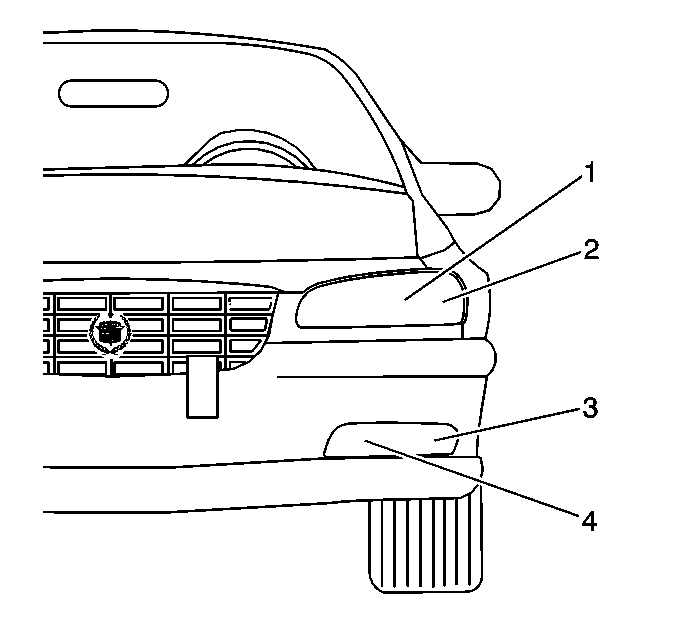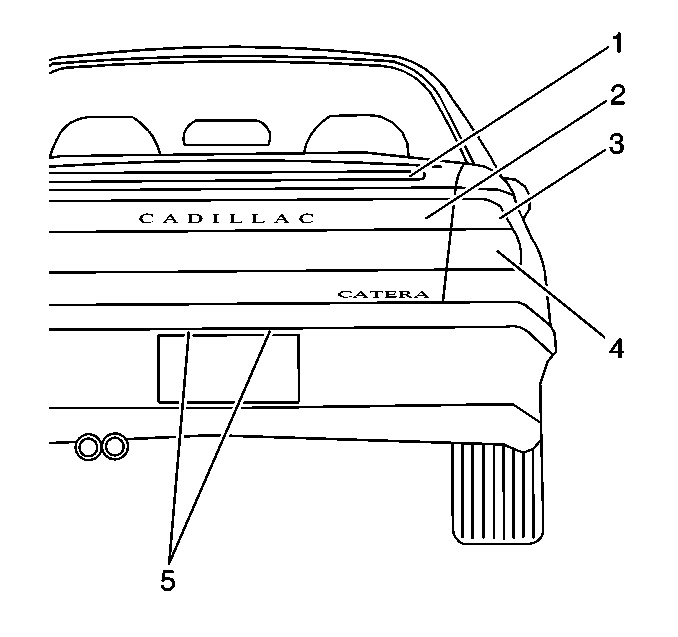Interior Lighting
The interior lighting features include retained accessory power for 10 minutes or until a door opens. The Remote Keyless Entry (RKE) and the door switch trigger the illuminated entry. Time delayed front interior lighting.
Refer to Instrument Panel, Gages and Console for information on the instrument cluster illumination/warning/indicator lamps.
Refer to Lighting Systems and Horns for circuit information.
Headlamp Switch
The following lamps illuminate when the headlamp switch rotates clockwise:
| • | The headlamps illuminate. |
| • | The sidemarker lamps illuminate. |
| • | The instrument panel lamps illuminate. |
A warning tone sounds as a reminder to turn the lamps off if the switch is on when the ignition switch if off.
Twilight Sentinel
The twilight sentinel provides an automatic on-off control of the headlamps. Refer to Theft Deterrent Systems for additional information.
Front and Rear Door Courtesy Lamp
The front door courtesy lamp is located in the lower part of the door. The rear door courtesy lamp is located in the lower part of the door. The front and rear door courtesy lamps illuminate under the following conditions:
| • | When any door opens. |
| • | When the interior lamps turn on. |
| • | When the Remote Keyless Entry (RKE) FOB triggers the applicable function. |
Exterior Lighting
The exterior lighting system includes the following lamps:

| • | The headlamps (1). |
| • | The fog and cornering lamps (3,and 4). |
| • | The front turn signal lamps (2). |

| • | The rear taillamps (4). |
| • | The rear turn signal (3). |
| • | The backup lamps (2). |
| • | The rear license lamps (5). |
| • | The highmount stoplamp (1). |
| • | The front sidemarker lamp. |
| • | The rear sidemarker lamp. |
| • | The rear compartment courtesy lamp. |
| • | The underhood lamp. |
Headlamp
Important: Ensure to follow the applicable state and local laws that specify requirements for headlamp aim.
The headlamp switch on the left side of the instrument panel controls the headlamps. The headlamps illuminate with the ignition switch in any position. A lights-on warning chime activates if the ignition switch is turned off with the light switch on.
The headlamp dimmer switch lever on the left side of the steering column controls the headlamp low beam and the headlamp high beam. Pull the lever toward the driver until the switch clicks to change the lamps from low beam to high beam or from high beam to low beam when the headlamps are on. An indicator lamp on the center instrument cluster comes on when the high beam headlamps are on.
The headlamps must be aimed for proper illumination of the road. Check the headlamp aim whenever installing a new headlamp or when service or repairs to the front end area may have disturbed the headlamp or the headlamp mountings.
Fog Lamp
The fog lamps use a halogen bulb. The fog lamps activate by the fog lamp icon button below the headlamp switch. The fog lamps are vertically adjustable by use of an adjusting screw below the lamp.
Cornering Lamp
The cornering lamps provide extra light in the direction the vehicle is turning. The cornering lamps illuminate with the turn signal when either the headlamps or the parking lamps are on. The corning lamps do not blink.
Front Sidemarker Lamp
The front sidemarker lamps illuminate when the exterior lighting system is on. The front sidemarker lamps have reflectors.
The appropriate front sidemarker lamp flashes in unison with the front turn signal lamp on the same side if the headlamp switch is off when a turn is signaled. The front sidemarker lamp and the front turn signal lamp flash alternately if the headlamp switch is on when a turn is signaled.
Front Turn Signal Lamp
The appropriate front parking lamp flashes to signal a turn when the turn signals activate. The turn signal works only when the ignition switch is in the ON position.
The turn signal lever on the left side of the steering column control the turn signals. Move the lever all the way up or down (beyond the detent) to turn on the turn signals. The lever returns to the horizontal and the turn signals stop flashing when the turn is completed.
Move the turn signal lever only to the first detent and hold it there to cancel the signal when changing lanes or making shallow turns where the steering wheel does not turn far enough to cancel the signal. The lever returns to horizontal and the turn signal cancel when the lever is released.
Turn Signal/Warning Lamp Flasher
The hazard warning lamp flasher is part of the turn signal circuit. The hazard warning switch is on the radio/heater control bezel. Depress the hazard warning switch button to cause the front and rear turn signal lamps and the sidemarker lamps to flash. Press the hazard warning switch knob again to turn off the hazard warning flashes.
The hazard warning flashes work with ignition switch in any position. The turn signals do not work when the hazard warning flashers are ON. The hazard warning flasher is in the convenience center behind the I/P driver knee bolster energy absorber directly below the steering column.
High-Mount Stoplamp
The high-mount stoplamp is in the center of the rear compartment lid. The high-mount stoplamp illuminates whenever the brake pedal pushes down. The high-mount stoplamp uses Light Emitting Diodes (LEDs) instead of conventional bulbs.
Rear Compartment Courtesy Lamp
The rear compartment courtesy lamp illuminates whenever the rear compartment lid opens. This applies even if the headlamps or the parking lamps are not on.
Rear License Lamp
The rear license lamp illuminates when the headlamps or the parking lamps are on. The license lamp mounts above the license plate inside the rear fascia.
Rear Sidemarker Lamp
The rear sidemarker lamp is located in the rear fascia. The rear sidemarker lamps illuminate when any of the following lamps are on:
| • | If the headlamps are on. |
| • | If the parking lamps are on. |
| • | If the turn signals and/or warning flashers are on. |
The rear sidemarker lamps have reflectors that shine when struck by light.
Taillamp
The following lamps are part of the taillamp:
| • | The taillamps. |
| • | The stoplamps. |
| • | The turn signal lamps. |
The taillamps illuminate whenever the headlamps or the parking lamps turn on. The taillamps glow brighter to serve as stoplamps when the brake pedal pushes down.
The turn signal lever on the left side of the steering column controls the turn signals. Move the lever all the way up or all the way down (beyond the detent) to run on the turn signals. The lever returns to neutral and the turn signals stop flashing when the turn completes. One side flashes and the other side stays on brightly if the brake pedal is held down when a turn is signaled.
Backup Lamp
The backup lamps are activated when the transmission position sensor switch is shifted to the REVERSE position. Refer to Transmission for service of the switch.
